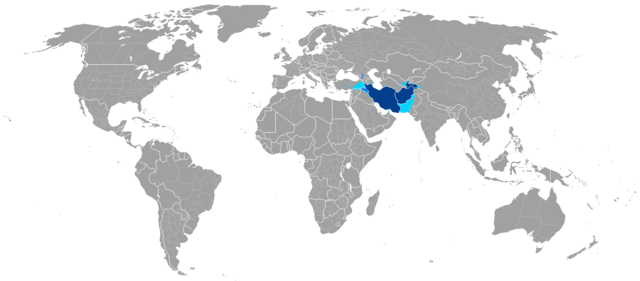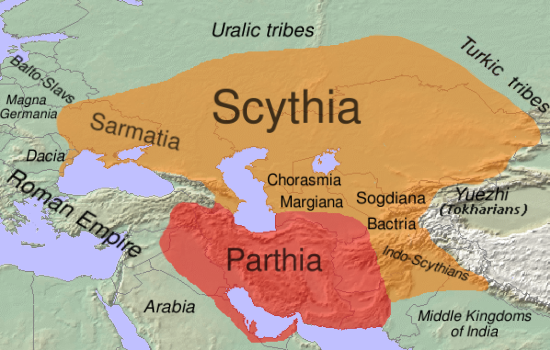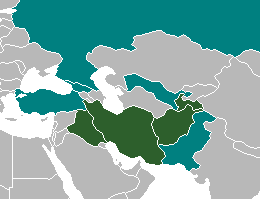
| IRANIAN LANGUAGES
Countries and areas where an Iranian language has official status or is spoken by a majority Ethnicity
: Iranian peoples
The Iranian or Iranic languages are a branch of the Indo-Iranian languages in the Indo-European language family that are spoken natively by the Iranian peoples.
The Iranian languages are grouped in three stages: Old Iranian (until 400 BC), Middle Iranian (400 BC – 900 AD), and New Iranian (since 900 AD). The two directly attested Old Iranian languages are Old Persian (from the Achaemenid Empire) and Old Avestan (the language of the Avesta). Of the Middle Iranian languages, the better understood and recorded ones are Middle Persian (from the Sasanian Empire), Parthian (from the Parthian Empire), and Bactrian (from the Kushan and Hephthalite empires).
As of 2008, there were an estimated 150–200 million native speakers of the Iranian languages. Ethnologue estimates that there are 86 Iranian languages, the largest among them being Persian, Pashto, Kurdish, and the Balochi languages.
Term
:
Some scholars such as John Perry prefer the term Iranic as the anthropological name for the linguistic family and ethnic groups of this category (many of which exist outside Iran), while Iranian for anything about the country Iran. He uses the same analogue as in differentiating German from Germanic or differentiating Turkish and Turkic.
This use of the term for the Iranian language family was introduced in 1836 by Christian Lassen. Robert Needham Cust used the term Irano-Aryan in 1878, and Orientalists such as George Abraham Grierson and Max Müller contrasted Irano-Aryan (Iranian) and Indo-Aryan (Indic). Some recent scholarship, primarily in German, has revived this convention.
The Iranian languages are divided into the following branches :
• The Western Iranian languages subdivided into:
• The Eastern Iranian languages subdivided into:
Proto-Iranian :
Historical distribution in 100 BC: shown are Sarmatia, Scythia, Bactria (Eastern Iranian, in orange); and the Parthian Empire (Western Iranian, in red) The Iranian languages all descend from a common ancestor: Proto-Iranian which itself evolved from Proto-Indo-Iranian. This ancestor language is speculated to have origins in Central Asia, and the Andronovo Culture is suggested as a candidate for the common Indo-Iranian culture around 2000 BC.[citation needed]
It was situated precisely in the western part of Central Asia that borders present-day Russia (and present-day Kazakhstan). It was in relative proximity to the other satem ethno-linguistic groups of the Indo-European family, like Thracian, Balto-Slavic and others, and to common Indo-European's original homeland (more precisely, the Eurasian Steppe to the north of the Caucasus), according to the reconstructed linguistic relationships of common Indo-European.
Proto-Iranian thus dates to some time after Proto-Indo-Iranian break-up, or the early second millennium BCE, as the Old Iranian languages began to break off and evolve separately as the various Iranian tribes migrated and settled in vast areas of southeastern Europe, the Iranian plateau, and Central Asia.
Proto-Iranian innovations compared to Proto-Indo-Iranian include: the turning of sibilant fricative *s into non-sibilant fricative glottal *h; the voiced aspirated plosives *bh, *dh, *gh yielding to the voiced unaspirated plosives *b, *d, *g resp.; the voiceless unaspirated stops *p, *t, *k before another consonant changing into fricatives *f, *0, *x resp.; voiceless aspirated stops *ph, *th, *kh turning into fricatives *f, *0, *x, resp.
Old
Iranian :
•
Avestan, the two languages/dialects of the Avesta, i.e. the liturgical
texts of Zoroastrianism.
Old Persian was an Old Iranian dialect as it was spoken in southwestern Iran (the modern-day province of Fars) by the inhabitants of Parsa, Persia or Persis who also gave their name to their region and language. Genuine Old Persian is best attested in one of the three languages of the Behistun inscription, composed circa 520 BC, and which is the last inscription (and only inscription of significant length) in which Old Persian is still grammatically correct. Later inscriptions are comparatively brief, and typically simply copies of words and phrases from earlier ones, often with grammatical errors, which suggests that by the 4th century BC the transition from Old Persian to Middle Persian was already far advanced, but efforts were still being made to retain an "old" quality for official proclamations.
The other directly attested Old Iranian dialects are the two forms of Avestan, which take their name from their use in the Avesta, the liturgical texts of indigenous Iranian religion that now goes by the name of Zoroastrianism but in the Avesta itself is simply known as vohu daena (later: behdin). The language of the Avesta is subdivided into two dialects, conventionally known as "Old (or 'Gathic') Avestan", and "Younger Avestan". These terms, which date to the 19th century, are slightly misleading since 'Younger Avestan' is not only much younger than 'Old Avestan', but also from a different geographic region. The Old Avestan dialect is very archaic, and at roughly the same stage of development as Rigvedic Sanskrit. On the other hand, Younger Avestan is at about the same linguistic stage as Old Persian, but by virtue of its use as a sacred language retained its "old" characteristics long after the Old Iranian languages had yielded to their Middle Iranian stage. Unlike Old Persian, which has Middle Persian as its known successor, Avestan has no clearly identifiable Middle Iranian stage (the effect of Middle Iranian is indistinguishable from effects due to other causes).
In addition to Old Persian and Avestan, which are the only directly attested Old Iranian languages, all Middle Iranian languages must have had a predecessor "Old Iranian" form of that language, and thus can all be said to have had an (at least hypothetical) "Old" form. Such hypothetical Old Iranian languages include Carduchian (the hypothetical predecessor to Kurdish) and Old Parthian. Additionally, the existence of unattested languages can sometimes be inferred from the impact they had on neighbouring languages. Such transfer is known to have occurred for Old Persian, which has (what is called) a "Median" substrate in some of its vocabulary. Also, foreign references to languages can also provide a hint to the existence of otherwise unattested languages, for example through toponyms/ethnonyms or in the recording of vocabulary, as Herodotus did for what he called "Scythian".
Isoglosses
:
Two of the earliest dialectal divisions among Iranian indeed happen to not follow the later division into Western and Eastern blocks. These concern the fate of the Proto-Indo-Iranian first-series palatal consonants, *c and *dz:
•
Avestan and most other Iranian languages have deaffricated and depalatalized
these consonants, and have *c > s, *dz > z.
•
Avestan and most other Iranian languages have shifted these clusters
to sp, zb.
•
Persid (Old Persian and its descendants)
Middle
Iranian languages :
The Western family includes Parthian (Arsacid Pahlavi) and Middle Persian, while Bactrian, Sogdian, Khwarezmian, Saka, and Old Ossetic (Scytho-Sarmatian) fall under the Eastern category. The two languages of the Western group were linguistically very close to each other, but quite distinct from their eastern counterparts. On the other hand, the Eastern group was an areal entity whose languages retained some similarity to Avestan. They were inscribed in various Aramaic-derived alphabets which had ultimately evolved from the Achaemenid Imperial Aramaic script, though Bactrian was written using an adapted Greek script.
Middle Persian (Pahlavi) was the official language under the Sasanian dynasty in Iran. It was in use from the 3rd century CE until the beginning of the 10th century. The script used for Middle Persian in this era underwent significant maturity. Middle Persian, Parthian and Sogdian were also used as literary languages by the Manichaeans, whose texts also survive in various non-Iranian languages, from Latin to Chinese. Manichaean texts were written in a script closely akin to the Syriac script.
New Iranian languages :
Dark green: countries where Iranian languages are official Teal: countries where Iranian languages are official in a subdivision Following the Islamic Conquest of Persia, there were important changes in the role of the different dialects within the Persian Empire. The old prestige form of Middle Iranian, also known as Pahlavi, was replaced by a new standard dialect called Dari as the official language of the court. The name Dari comes from the word darbâr, which refers to the royal court, where many of the poets, protagonists, and patrons of the literature flourished. The Saffarid dynasty in particular was the first in a line of many dynasties to officially adopt the new language in 875 CE. Dari may have been heavily influenced by regional dialects of eastern Iran, whereas the earlier Pahlavi standard was based more on western dialects. This new prestige dialect became the basis of Standard New Persian. Medieval Iranian scholars such as Abdullah Ibn al-Muqaffa (8th century) and Ibn al-Nadim (10th century) associated the term "Dari" with the eastern province of Khorasan, while they used the term "Pahlavi" to describe the dialects of the northwestern areas between Isfahan and Azerbaijan, and "Pârsi" ("Persian" proper) to describe the Dialects of Fars. They also noted that the unofficial language of the royalty itself was yet another dialect, "Khuzi", associated with the western province of Khuzestan.
Geographic distribution of modern Iranian languages The Islamic conquest also brought with it the adoption of Arabic script for writing Persian and much later, Kurdish, Pashto and Balochi. All three were adapted to the writing by the addition of a few letters. This development probably occurred some time during the second half of the 8th century, when the old middle Persian script began dwindling in usage. The Arabic script remains in use in contemporary modern Persian. Tajik script, used to write the Tajik language, was first Latinised in the 1920s under the then Soviet nationality policy. The script was however subsequently Cyrillicized in the 1930s by the Soviet government.
The geographical regions in which Iranian languages were spoken were pushed back in several areas by newly neighbouring languages. Arabic spread into some parts of Western Iran (Khuzestan), and Turkic languages spread through much of Central Asia, displacing various Iranian languages such as Sogdian and Bactrian in parts of what is today Turkmenistan, Uzbekistan and Tajikistan. In Eastern Europe, mostly comprising the territory of modern-day Ukraine, southern European Russia, and parts of the Balkans, the core region of the native Scythians, Sarmatians, and Alans had been decisively taken over as a result of absorption and assimilation (e.g. Slavicisation) by the various Proto-Slavic population of the region, by the 6th century AD. This resulted in the displacement and extinction of the once predominant Scythian languages of the region. Sogdian's close relative Yaghnobi barely survives in a small area of the Zarafshan valley east of Samarkand, and Saka as Ossetic in the Caucasus, which is the sole remnant of the once predominant Scythian languages in Eastern Europe proper and large parts of the North Caucasus. Various small Iranian languages in the Pamir Mountains survive that are derived from Eastern Iranian.
Source :
https://en.wikipedia.org/ |



